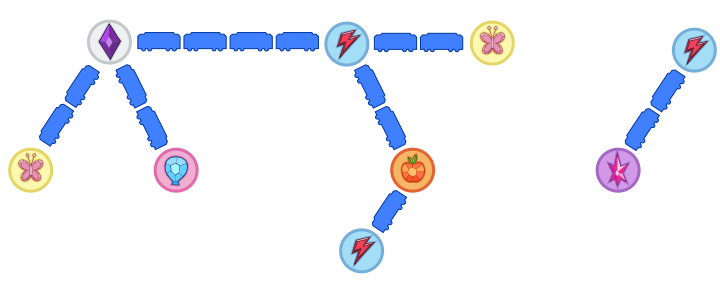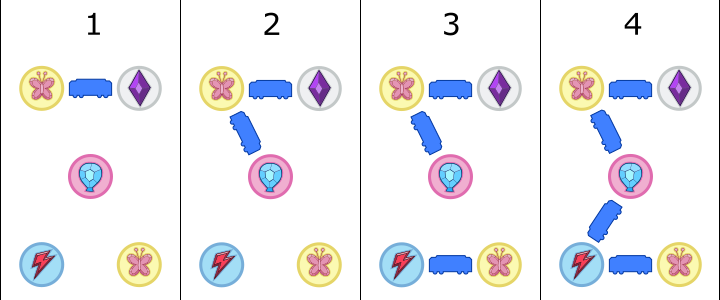
For the rules of Ticket to Ride, see your original printed TTR rulebook or the Days of Wonder website. This page describes details specific to Ticket to Ride: Equestria.
Players: TTR Equestria supports 2 to 5 players. Double routes are in play with 4 or more players in the game. With 2 or 3 players, only one side of each double route may be claimed.
Trains: TTR Equestria uses 40 trains per player, like several of the official TTR map expansions. If playing with a base set that includes 45 trains, remove 5 from each player's stock before starting play.
Tickets: Standard rules as per TTR USA. At the beginning of the game, each player draws 4 tickets and must keep 2 or more. During the game, when drawing more tickets, a player draws 3 and must keep 1 or more. All discarded tickets are placed on the bottom of the ticket deck. Keep your tickets secret during the game and reveal them only at the end.
Locomotive wild cards: Standard rules as per TTR USA. They may be used for any route, and taking one face-up from the table consumes a full turn. If three locomotives are ever on the board at the same time, discard all five cards from the board and draw five new ones from the deck.
Scoring: Standard rules for all TTR maps. Routes score 1/2/4/7/10/15/18 points for route lengths of 1/2/3/4/5/6/7. This is indicated with the train icon in the top center of the map.
Other: There are no ferry or tunnel routes in TTR Equestria. Train stations included with the Europe base game are not used in this version. The game ends with the same condition as for all TTR maps: when one player goes down to two trains remaining, then all players get one more turn.
There are no bonuses for longest path or most tickets completed. Instead, bonus points are earned for completing sets of the Elements of Harmony, as follows.

Each city in Equestria is represented by one of the Elements of Harmony: Generosity (white), Honesty (orange), Kindness (yellow), Laughter (pink), Loyalty (blue), and Magic (purple). For every city connected to by a player's trains, that player gets credit for one copy of that Element. These cities do not have to be contiguously connected by the player's trains; any train at the city is enough.
At the end of the game, each player scores 6 points for every complete set of 6 distinct Elements they have achieved. Extra elements that do not form a complete set score no points.
Additionally, the player with the most completed sets of Elements scores an additional 12 point bonus. If multiple players are tied for this bonus, divide the 12 points evenly among all tied players.
In the example above, the blue player has one complete set of Elements for 6 points. Note that the Magic element on the right does not need to be connected to the rest; just the single connection to the neighboring Loyalty element is enough. This player has one Generosity element (not three); each city is counted only once. This player has two Kindness elements and three Loyalty elements, but these extra elements don't score any additional points since they don't complete a second or third full set.
Tracking: You can count up all the Elements at the end of the game. However, it's recommended to keep track of them during the game, so that players will know what elements they've got and which they need to complete sets. Use the chits provided and described on the printing page for this. Each time you connect to a new city, take a chit token to represent that element.

This example describes four turns by the blue player and each of the situations commonly encountered.
Turn 1: She plays between the Kindness and Generosity elements, and takes a token for each.
Turn 2: She plays between the Kindness and Laughter elements. She already has that Kindness city, so takes only a Laughter token.
Turn 3: She plays between the Loyalty and second Kindness elements. These are both new cities for her, so she takes a token for each, now possessing one Loyalty and two Kindness.
Turn 4: She plays between the Laughter and Loyalty elements. She already had both of these cities, so she claims no new cities and takes no new tokens.
 Now she has these tokens, and can easily tell that she will need to add a Magic and an Honesty element to complete the set.
Now she has these tokens, and can easily tell that she will need to add a Magic and an Honesty element to complete the set.
If this is your first time playing Ticket to Ride, try to keep the following in mind:
Look for tickets which share a similar route to make completing them all easier.
Think about drawing new ticket cards when you are very close to completing your old ones.
Don't worry about rushing to grab routes you need very early in the game, instead focus on collecting train cards you know you'll need and planning a route.
Are there no train cards face up in the colors you need? Try drawing from the top of the deck, or just pick up a wild card (a bird in the hoof...) Still nothing? Spend a turn claiming another route you need and wait for the other players to maybe pick up some of the cards you don't want.
Need to claim multiple routes over several turns in a row? Make sure you grab the routes which are easier for other players to claim (usually the short or the gray routes) to minimize the chances of getting blocked by another player who might also need those routes.
Near the end of the game, look out for easy-to-claim routes which connect to Elements you need to complete your sets. You will get an element token for connecting to a city for the first time, even if it's nowhere near any of your other routes. A route disconnected from any of your other trains will score you two new Elements. Just one more complete set might mean the difference between a shared bonus, the whole bonus, or no bonus at all!